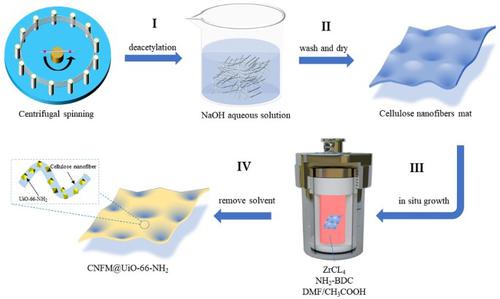Frontiers of Chemical Science and Engineering ( IF 4.3 ) Pub Date : 2022-05-02 , DOI: 10.1007/s11705-022-2154-2 Yuyao Han 1, 2 , Lei Xia 1, 2 , Xupin Zhuang 1, 2 , Yuxia Liang 3

|
UiO-66-NH2 is an efficient material for removing pollutants from wastewater due to its high specific surface area, high porosity and water stability. However, recycling them from wastewater is difficult. In this study, the cellulose nanofibers mat deacetylated from cellulose acetate nanofibers were used to combine with UiO-66-NH2 by the method of in-situ growth to remove the toxic dye, rose bengal. Compared to previous work, the prepared composite could not only provide ease of separation of UiO-66-NH2 from the water after adsorption but also demonstrate better adsorption capacity (683 mg·g−1 (T = 25 °C, pH = 3)) than that of the simple UiO-66-NH2 (309.6 mg·g−1 (T = 25 °C, pH = 3)). Through the analysis of adsorption kinetics and isotherms, the adsorption for rose bengal is mainly suitable for the pseudo-second-order kinetic model and Freundlich model. Furthermore, the relevant research revealed that the main adsorption mechanism of the composite was electrostatic interaction, hydrogen bonding and π—π interaction. Overall, the approach depicts an efficient model for integrating metal-organic frameworks on cellulose nanofibers to improve metal-organic framework recovery performance with potentially broad applications.
中文翻译:

金属有机骨架 UiO-66-NH2 和纤维素纳米纤维垫的集成用于染料玫瑰红的高性能吸附
UiO-66-NH 2具有高比表面积、高孔隙率和水稳定性,是一种有效去除废水中污染物的材料。然而,从废水中回收它们是困难的。本研究将醋酸纤维素纳米纤维脱乙酰化后的纤维素纳米纤维毡通过原位生长的方法与UiO-66-NH 2结合,去除有毒染料孟加拉红。与以往的工作相比,所制备的复合材料不仅易于吸附后从水中分离 UiO-66-NH 2,而且表现出更好的吸附容量(683 mg·g -1 ( T = 25 °C, pH = 3 )) 比简单的 UiO-66-NH 2(309.6 mg·g -1 ( T = 25 °C, pH = 3))。通过吸附动力学和等温线分析,玫瑰红的吸附主要适用于准二级动力学模型和Freundlich模型。此外,相关研究表明,该复合材料的主要吸附机理为静电相互作用、氢键和π - π相互作用。总体而言,该方法描述了一种在纤维素纳米纤维上整合金属有机框架以提高金属有机框架恢复性能的有效模型,具有潜在的广泛应用。











































 京公网安备 11010802027423号
京公网安备 11010802027423号